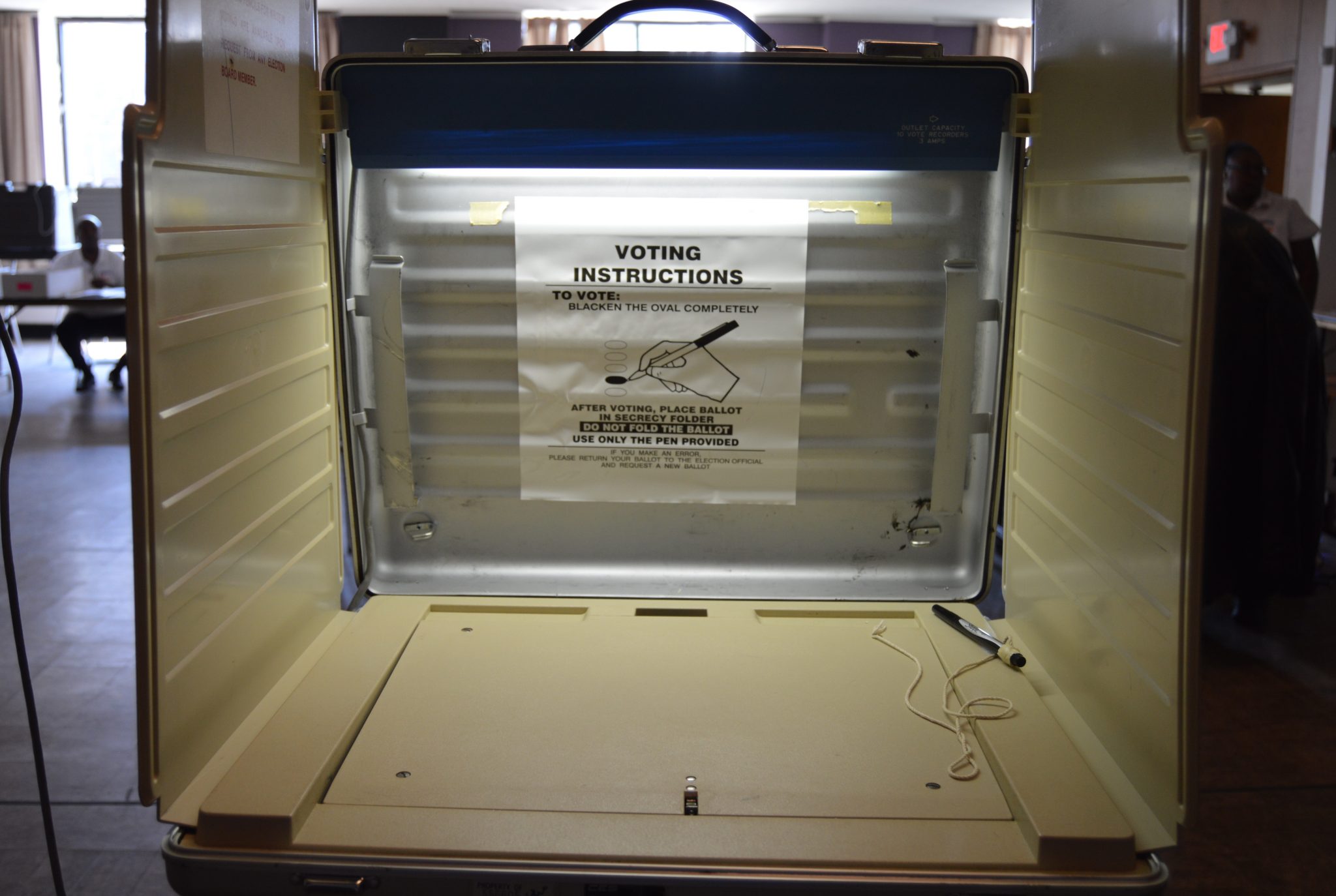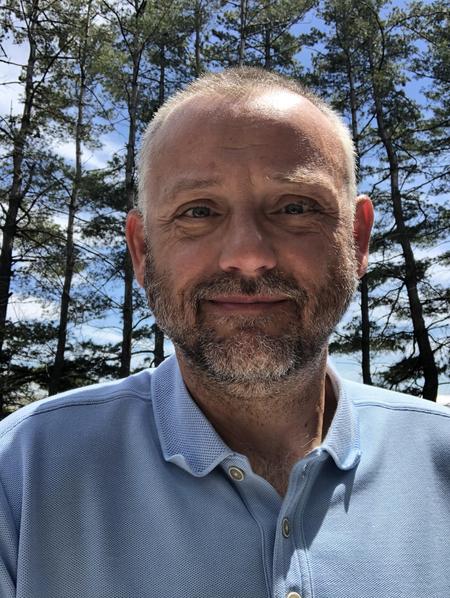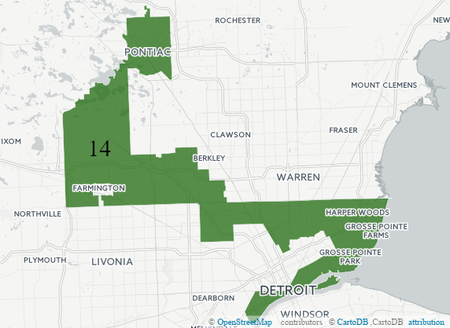Voters Not Politicians: The Cons [TRANSCRIPT]
Jamie Roe explains why people should vote “no” on the proposal to change how political districts are determined.


If this November’s statewide ballot allows Michigan voters the choice to change the process of drawing the state’s political maps, Jamie Roe says they should vote “no.”
Roe, a political consultant with Grand River Strategies, says the proposal is too broad and would unfairly favor Democrats.
WDET’s Pat Batcheller spoke with Roe, whose firm represents conservative clients.
Click on the audio player above to hear their conversation.
You can find a transcript of it below.
Here’s some other WDET work on the gerrymandering issue:
Policy Meets the People: Introducing the Issue of Gerrymandering
WATCH HERE: A live one-hour show with an in-studio audience and guests
On DETROIT TODAY: Was Racism Involved in the Drawing of Michigan’s Congressional Districts?
A Podcast Playlist – Become a Gerrymandering Expert Just By Listening
MichMash: Here’s How You Can Influence The Drawing of District Lines in Michigan
Gerrymandering: Why It’s a Technology Issue [TRANSCRIPT]
Voters Not Politicians: The Cons [TRANSCRIPT]
Pat Batcheller: What is wrong with the Voters Not Politicians proposal?
Jamie Roe: One thing about it is that it’s a solution in search of a problem. We actually have a historic system here in Michigan where our districts are based upon the Apol Standard, which was developed by a former state elections director named Bernie Apol. He was appointed a special master by the Michigan Supreme Court in the 1980 redistricting process, when the two parties couldn’t come together on a map. And he was appointed by the chief justice at the time, Charles Levin, who was actually an independent-nominated Supreme Court justice. And those standards require us to maintain the integrity of communities across the state. We break as few city, township, and county lines as possible so that we maintain communities, and so they can best represent the people who live in those communities.
Batcheller: So, how do you end up, then, with a district that looks like the 14th Congressional District?
Roe: There’s another standard you have to meet. It’s not just keeping communities together, which actually splits very few communities. It’s to comply with the federal Voting Rights Act. The federal Voting Rights Act, when it was passed in 1964, required if you can build majority-minority districts—and in this case, two majority African-American districts, which Detroit has had since the advent of the Voting Rights Act—that you MUST build two African-American majority districts. And as we’ve seen in the last 30 years in this area, you’ve had a migration of a large number of African-Americans out of the city of Detroit and across the Metro Detroit area. And so that district and the other majority African-American district we have in Michigan (the 13th) follow that migration.

If you want to keep those districts majority African-American, then you have to follow the migration of where the African-Americans have moved across our community. And that’s what that district does. And the proponents who want to stop districts like that, the question I would ask them is “do you not believe that we should have two majority African-American districts in Michigan anymore?” Because if you just wanted to maintain a community, the City of Detroit right now would be about one congressional district. So you could have one district that represents the City of Detroit, and you’d have one African-American district, and you have no possibility of building another one. So, what competing interest do you want to have? Do you want to follow the federal Voting Rights Act, or do you want to follow the Apol standards? That (district) is one where I think we’ve followed both, because it does split very few communities. People don’t like the shape. If you look at the rest of our map, our districts are very compact and not oddly-shaped, except for the two Voting Rights Act districts. They’re different.
Batcheller: Why won’t the Voters Not Politicians proposal work?
Roe: A couple problems with it. Number one, it would remove our standards of keeping communities intact. I live in Macomb Township, so you don’t divide Macomb Township. If you can keep Macomb Township whole, you keep Macomb Township whole. And they would remove protecting communities and replace it with protecting “communities of interest”, which are undefined. And I would say the group of Democrats that’s behind Voters Not Politicians believes that communities of interest are disparate Democrat voting blocs that they would like to combine to create more Democrat districts. The other thing about it that’s wrong is that it judges districts on another undefined term, called “accepted measures of political fairness.” Now, I don’t know what the measures of political fairness are, and I’m not sure who’s doing the accepting. But that is what they’re going to try and enshrine into our (state) constitution. And, I would argue, for the first time ever enshrine gerrymandering into our constitution. Because right now, nothing in our state law, nothing in our state constitution, the drawing of maps—political considerations have nothing to do with the drawing of maps.
Batcheller: I looked at election results from the last two elections, 2016 and 2014. What I found was that in 2016, when you add up ALL of the votes for everybody who ran for Congress statewide, Republicans won 48 percent of the TOTAL vote. Democrats won 47 percent. That’s a one point difference. That same year, Democrats and Republicans each got about 49 percent of all the votes cast in State House races, a half-point difference (favoring Democrats) there. And then, in 2014, the last State Senate campaign, Republicans won a narrow majority of all votes cast in all 38 State Senate districts. That’s about 1.5 percent more than Democrats won. Those numbers, plus taking into account President Trump’s narrow victory in Michigan would suggest a state that is pretty well split between Republicans and Democrats, about 50-50. Yet, you’ve got a 12-seat majority in the State House, a more than two-thirds supermajority in the State Senate, and 9 seats for Republicans in the (U.S.) House, as opposed to 5 Democrats. If partisan redistricting—or as critics call it, “gerrymandering”—doesn’t explain that, what does?
Roe: Geography is what explains it. It’s pretty simple. Our districts are based on geography. Democrat voters tend to live in the same area. The city of Detroit is 90-plus percent Democrat. So, it’s hard to draw a district in Detroit where Republicans are going to get more than, say, 10 percent of the vote. Now, is that fair? Republicans choose not to live there, so they’re not going to do well in those districts. Democrats tend to group in certain urban geographic areas—university towns, big cities, etc. Republicans are more evenly split across the state. So, because we draw our districts based on geography, that is one reason why you have those disparities. Now, if you wanted to have spaghetti-shaped districts that come out of the city of Detroit and spread throughout the suburbs, I’m sure—I do believe ultimately that’s what the Voters Not Politicians people want to do. So, while they decry the 14th District, I would argue that if you took their political fairness argument to another level, you would have countless 14th Districts across this state, as they use urban Democrat) votes to try and build suburban Democrat voting districts. That’s ultimately what they decided to do. And I’ll tell you one other aspect you’re going to have, as we’re discussing the 14th District. If you did that, you’d have a whole lot less African-Americans serving in our state legislative process. That is an issue that they never talk about. You talk to the Voters Not Politicians people, they will never talk about that, because if they get what they want, you’re going to get less African-Americans involved in our state government.
[Editor’s note: Voters Not Politicians says the proposal, if it passes, requires the new redistricting commission to follow the Voting Rights Act.]
Batcheller: So, can either party, or any party be trusted not to draw maps to their advantage? Democrats may argue Republicans have got the advantage and don’t want to give it up, and that’s why they’re opposing this.
Roe: I’ve been doing politics a long time. One thing that matters: Candidates matter. OK? Now, if you look at the state House in 2014, Republicans won 63 of the 110 state house districts. Gary Peters (D), in his U.S Senate race against Terri Lynn Land (R), won 72 of those districts. He carried 72 of those districts that Republicans were winning around 60 of them. Democrats can compete in those districts if they have strong candidates. The fact of the matter is in a district like Alpena, if you’re not pro-life and pro-gun, you’re not going to win in Alpena, OK? They nominate the most liberal candidate they can find that cannot compete in the general election. That’s not the Republican Party’s fault. That’s the Democratic Party’s fault. So they have to think about finding candidates that fit their district. And if you look at a recent election in Pennsylvania, you had a guy named Conor Lamb running as a Democrat. I call him a unicorn, because he was ostensibly against abortion and in favor of gun rights, etc. etc. in sort of a district like where I come from, who was PICKED by the party, wasn’t nominated by the party. There was no primary. And I would just argue this—that a candidate like that can’t win a Democratic primary. So that’s a problem they have. They choose the most liberal candidate they can, and liberal candidates can’t win in the general election. So candidates and campaigns matter. We run good candidates and good campaigns, and they don’t.
Batcheller: Ohio just approved a redistricting amendment with wide bipartisan support. It passed by a 3-1 margin. It’s NOT the same as the one we’re talking about here. Their redistricting process will change, but it will start in the legislature, and if they don’t get a certain number of votes there, then it goes to a redistricting committee after that. There are key differences between what passed in Ohio and what voters might decide in Michigan. But, the bottom line is voters still got to decide that issue in Ohio. Why shouldn’t this question be put on the ballot and let the voters decide?
Roe: I don’t think we should take the chance on it passing, to be honest with you.
Batcheller: But shouldn’t that be the voters’ call?
Roe: The legislature put that proposal on the ballot in Ohio, and it was passed. I think they saw a problem and they fixed it in the way that they chose. Quite frankly, I don’t think we have a problem in Michigan right now. The Voters Not Politicians proposal takes a process that is given to the legislature and signed by the governor in a full, open legislative hearing, the public’s invited to come, put in their two cents, submit plans if they want—all of which happened in the previous round of redistricting—and replaces it with 13 people whose names are pulled out of a hat. Anybody with relevant experience is instantly eliminated from consideration. So, if you’ve been as much as a precinct delegate for either party, you are not allowed. If you’re a grass-roots activist for either party, you’re not allowed to participate. If you’ve been an elected official, if you’ve been involved in politics in any way, you’re basically denied participation. Also, the family members of anybody who’s been involved are denied participation. For instance, I am ineligible because of decisions that I made to be involved in politics. My mother is ineligible because of a decision I made. Not because of a decision SHE made. She has her political rights stripped away because of a decision I made. And quite frankly, I think that’s unconstitutional at the federal level. And anyway, you’re going to take these 13 people, empower them to draw these maps, have absolutely no accountability on them whatsoever. They can’t be fired, they can’t be terminated, you’re going to pay them $40,000 a year, they’re going to have to show up to a couple of meetings and decide, if they need more money, they actually have to be given more money. So they can appropriate state tax dollars. Right now, only state legislators can appropriate state tax dollars. They can appropriate state tax dollars with impunity. They also have the most limited judicial review I’ve ever seen in my life. If people believe the law wasn’t abided, it goes to the Michigan Supreme Court, which can’t redraw the map and fix the problem, they can only send it back to this group to draw a new map if they find a problem. So this proposal is just—the system that they choose to do this is ridiculous, in my opinion.
Batcheller: More than 400,000 people, so there does seem to be some public support for getting this issue on the ballot.
Roe: I saw the circulators out there, and I’ll say they did a pretty good job. But the way they sold this thing was the 14th Congressional District. They would hold up a map of the District and say, “look at this, isn’t this terrible? Let’s stop this!” and “voters should choose their politicians, politicians shouldn’t choose their voters,” which is a catchy slogan, but it’s basically…it’s ridiculous in my opinion. I would say protect our communities, reject Voters Not Politicians. Otherwise, they’re going to slice-and-dice my community and have a district that goes down, Schoenherr Road all the way to downtown Detroit so they can build a competitive district. The solution to the problem is worse than the problem—if a problem actually exists.
MORE FROM WDET:
How “Red” or “Blue” Are Michigan’s Political Maps?

